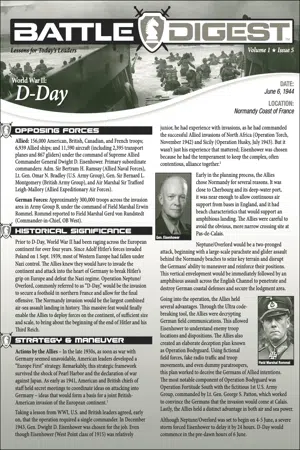![]()
BATTLE DIGEST
Lessons for Today’s Leaders Volume 1 * Issue 5
World War II:
D-Day
DATE:
June 6, 1944
LOCATION:
Normandy Coast of France
Allied: 156,000 American, British, Canadian, and French troops; 6,939 Allied ships; and 11,590 aircraft (including 2,395 transport planes and 867 gliders) under the command of Supreme Allied Commander General Dwight D. Eisenhower. Primary subordinate commanders: Adm. Sir Bertram H. Ramsay (Allied Naval Forces), Lt. Gen. Omar N. Bradley (U.S. Army Group), Gen. Sir Bernard L. Montgomery (British Army Group), and Air Marshal Sir Trafford Leigh-Mallory (Allied Expeditionary Air Forces).
German Forces: Approximately 300,000 troops across the invasion area in Army Group B, under the command of Field Marshal Erwin Rommel. Rommel reported to Field Marshal Gerd von Rundstedt (Commander-in-Chief, OB West).
Prior to D-Day, World War II had been raging across the European continent for over four years. Since Adolf Hitler’s forces invaded Poland on 1 Sept. 1939, most of Western Europe had fallen under Nazi control. The Allies knew they would have to invade the continent and attack into the heart of Germany to break Hitler’s grip on Europe and defeat the Nazi regime. Operation Neptune/ Overlord, commonly referred to as “D-Day,” would be the invasion to secure a foothold in northern France and allow for the final offensive. The Normandy invasion would be the largest combined air-sea assault landing in history. This massive feat would finally enable the Allies to deploy forces on the continent, of sufficient size and scale, to bring about the beginning of the end of Hitler and his Third Reich.
Actions by the Allies – In the late 1930s, as soon as war with Germany seemed unavoidable, American leaders developed a “Europe First” strategy. Remarkably, this strategic framework survived the shock of Pearl Harbor and the declaration of war against Japan. As early as 1941, American and British chiefs of staff held secret meetings to coordinate ideas on attacking into Germany – ideas that would form a basis for a joint British-American invasion of the European continent.1
Taking a lesson from WWI, U.S. and British leaders agreed, early on, that the operation required a single commander. In December 1943, Gen. Dwight D. Eisenhower was chosen for the job. Even though Eisenhower (West Point class of 1915) was relatively junior, he had experience with invasions, as he had commanded the successful Allied invasions of North Africa (Operatio...
